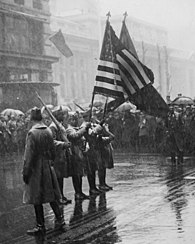92nd Infantry Division (United States)
| 92nd Division 92nd Infantry Division (Colored) | |
|---|---|
 Shoulder sleeve insignia | |
| Active | 1917–1919 1942–1945 |
| Country | |
| Branch | |
| Type | Infantry |
| Size | Division |
| Nickname(s) | "Buffalo Soldiers" |
| Motto(s) | "Deeds, not Words" |
| Engagements | World War I |
| Commanders | |
| Notable commanders | Maj. Gen. Edward M. Almond |
| Insignia | |
| Distinctive unit insignia | 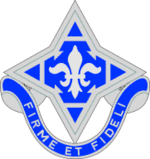 |
The 92nd Infantry Division (92nd Division, WWI) was a segregated infantry division of the United States Army that served in both World War I and World War II. The division was organized in October 1917, after the U.S. entry into World War I, at Camp Funston, Kansas, with African American soldiers from all states. In 1918, before leaving for France, the American buffalo was selected as the divisional insignia due to the "Buffalo Soldiers" nickname, given to African American cavalrymen in the 19th century. The "Buffalo Soldiers Division" divisional nickname was inherited from the 366th Infantry, one of the first units of the division organized.
The 92nd Infantry Division was the only African American infantry division to see combat in Europe during World War II, as part of the U.S. Fifth Army, fighting in the Italian Campaign.[1] The division served in the Italian Campaign from 1944 to the war's end.
History
World War I

- Activated: October 1917[2]
- Overseas: 18 July 1918
- Major operations: Meuse-Argonne less field artillery
- Casualties: total: 1,647 (KIA: 120; WIA: 1,527).
- Commanders: Maj. Gen. Charles C. Ballou (29 October 1917), Maj. Gen. Charles Henry Martin (19 November 1918), Brig. Gen. James B. Erwin (16 December 1918).
- Returned to United States and inactivated: February 1919.
The 92nd Division was first constituted on paper 24 October 1917 in the National Army, over six months after the U.S. entry into World War I.[3] The division was commanded throughout most of its existence by Major General Charles C. Ballou and was composed of the 183rd Infantry Brigade with the 365th and 366th Infantry Regiments, and the 184th Infantry Brigade with the 367th and 368th Infantry Regiments, together with supporting artillery, engineer, medical and signal units attached.[4]
The division was organized on 27 October 1917 at eight camps throughout the United States, as the War Department had not made provision for a single cantonment for this unit and it was necessary to distribute it widely throughout the Midwest and East Coast: at Camp Funston on the grounds of Fort Riley, Kansas; Camp Dodge, Iowa; Camp Grant, Illinois; Camp Sherman, Ohio; Camp Meade, Maryland; Camp Dix, New Jersey; Camp Upton, New York. All of the enlisted personnel were African American, along with about four-fifths of the officers; the staff and field grade officers, supply, artillery, engineer, and quartermaster officers were all white with only a few exception.[5] For this division, 104 black captains, 397 first lieutenants, and 125 second lieutenants were trained at a "negro officers' camp" in Des Moines, Iowa.[6]
A special "negro zone" was to be built at the east end of Camp Funston, with "separate amusement places and exchanges." A.D. Jellison, a banker of Junction City, Kansas, gave a plot of land for a "community house," to be erected by the black men from the seven states which sent African-American trainees to the camp.[7]
As was the case with the 93rd Division, parts of the 92nd served under and alongside the French Army after both the main American Expeditionary Force, adhering to the racial policies of the progressive President Woodrow Wilson, Secretary of War Newton D. Baker, and southern Democrats who promoted the "separate but equal" doctrine, refused to allow African-American soldiers serve in combat with them.[citation needed]
They 92nd, when it arrived on the Western Front, was a green and untried unit that was not allowed to maneuver as a division before they were committed to the line. After arrival, the 92nd, like all AEF units, trained for deployment in the trenches. They began to be fed into the French sector front lines by company in mid-August 1918. The 92nd Artillery Brigade came on line only in October 1918.[citation needed] Ralph Waldo Tyler was assigned to report on the 92nd Division by Secretary of War, Newton Baker. Tyler was the first and at the time, only accredited African American reporting on the Great War.
The 92nd Division saw combat in the Meuse-Argonne Offensive during November 1918.[citation needed]
Units

92nd Division (1917–19)
- Headquarters, 92nd Division[8]
- 183rd Infantry Brigade
- 365th Infantry Regiment
- 366th Infantry Regiment
- 350th Machine Gun Battalion
- 184th Infantry Brigade
- 367th Infantry Regiment
- 368th Infantry Regiment
- 351st Machine Gun Battalion
- 167th Field Artillery Brigade
- 349th Field Artillery Regiment
- 350th Field Artillery Regiment
- 351st Field Artillery Regiment
- 317th Trench Mortar Battery
- 349th Machine Gun Battalion
- 317th Engineer Regiment
- 317th Medical Regiment
- 317th Field Signal Battalion
- Headquarters Troop, 92nd Division
- 317th Train Headquarters and Military Police
- 317th Ammunition Train
- 317th Supply Train
- 317th Engineer Train
- 317th Sanitary Train
- 365th, 366th, 367th, and 368th Ambulance Companies and Field Hospitals
World War II
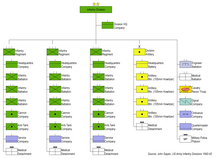
- Activated: 15 October 1942.
- Overseas: 22 September 1944.
- Campaigns: North Apennines, Po Valley.
- Awards: Medal of Honor: 2 (1 Posthumously in 1997); Distinguished Service Cross (United States): 2; Army Distinguished Service Medal: 1; Silver Star: 208; Legion of Merit: 16; Soldier's Medal: 6; Bronze Star: 1,166; Purple Heart: 1,891; Order of the Crown of Italy: 8; Military Cross for Military Valor (Italian): 17; Military Cross for Merit in War (Italian): 22; War Medal (Brazil): 1
- Commanders: Maj. Gen. Edward Almond (October 1942 – August 1945), Brig. Gen. John E. Wood (August 1945 to inactivation).
- Returned to the United States: 26 November 1945.
- Inactivated: 28 November 1945.

The division was reactivated as an infantry division with the "colored" designation, under the command of Major General Edward Almond, on 15 October 1942, ten months after the American entry into World War II, at Fort Huachuca, Arizona and spent almost two years training in the United States. In late July 1944, the 370th Infantry Regiment was sent overseas to Italy and temporarily attached to the 1st Armored Division. The rest of the division would be sent overseas in September of that year, and the division as a whole would see heavy combat during the remainder of the Italian Campaign.
During the 92nd Division's participation in the Italian Front, the Buffalo Soldiers made contact with units of many nationalities: beyond the attached 442nd Regimental Combat Team (442nd RCT), they also had contact with the colonial troops of the British and French colonial empires (Moroccans, Algerians, Senegalese, Indians, Gurkhas, Arab and Jewish Palestinians) as well as with exiled Poles, Greeks and Czechs, anti-fascist Italians and the troops of the Brazilian Expeditionary Force (FEB).[9][10][11]
The division's magazine was The Buffalo.[12] Its art director, Ted Shearer, would go on to create the early African-American comic strip Quincy.[13]
Commanders

The division's commander, Major General Edward Almond, was for a time highly regarded by General George Marshall, the U.S. Army Chief of Staff, who was a fellow Virginia Military Institute (VMI) graduate. This was a major factor in Almond's promotion to major general and subsequent command of the division, a position he held from its formation in October 1942 until August 1945. He led the division in combat throughout the Italian Campaign of 1944–1945. Almond was chosen by General Marshall to command the division because he believed Almond would excel at what was seen as a difficult assignment. However, Almond performed poorly and went on to blame his poor performance on the fact that the division was made up of largely African American troops. He saw his troops as the source of his failure in combat, and went on to advise the army against ever again using African American soldiers as combat troops.[14]
Combat chronicle

The 370th Regimental Combat Team, attached to the 1st Armored Division, arrived in Naples, Italy, 1 August 1944 and entered combat on the 24th. It participated in the crossing of the Arno River, the occupation of Lucca and the penetration of the Gothic Line. Enemy resistance was negligible in its area. As Task Force 92, elements of the 92nd attacked on the Ligurian coastal flank toward Massa, 5 October. By the 12th, the slight gains achieved were lost to counterattacks. On 13 October, the remainder of the division concentrated for patrol activities. Elements of the 92nd moved to the Serchio sector, 3 November 1944, and advanced in the Serchio River Valley against light resistance, but the attempt to capture Castelnuovo di Garfagnana did not succeed. Patrol activities continued until 26 December when the enemy attacked, forcing units of the 92nd to withdraw. The attack ended on 28 December. The attacking forces were mainly from the Republic of Salò's Fascist Army, the 4th Italian "Monte Rosa" Alpine Division (four battalions), with the support of three German battalions. Aside from patrols and reconnaissance, units of the 92nd attacked enemy forces in the Serchio sector from 5–8 February 1945, advancing against the 1st "Italia" Bersaglieri Division, but enemy counterattacks soon reversed all 92nd Division advances.
After continuing poor combat performance including many instances of unauthorized withdrawals upon meeting the enemy, low morale and malingering, the 92nd Infantry Division was considered of inferior quality both by German and U.S. commands, and fit for only defensive roles. Because of this perception, and the fact that African-American infantry replacements were in extremely short supply and thus precluded the use of the full division in sustained offensive action, U.S. Fifth Army leadership decided to withdraw the division from the front lines and rebuilt in early 1945. The 365th Infantry Regiment became a training and replacement regiment for the division. The 366th Infantry Regiment was relieved from attachment to the division and was formed into two engineer general service regiments. The 370th Infantry Regiment remained assigned to the division, and was rebuilt by transferring outstanding enlisted men and officers from the other two assigned African-American regiments of the division. The 371st Infantry Regiment was relieved from assignment to the division and used under Fifth Army control. The 473rd Infantry Regiment, formed from unneeded antiaircraft troops, and the famous and highly decorated nisei 442nd Infantry Regiment, made up of Japanese Americans, was assigned to bolster the division's combat effectiveness.[15]
Contemporary historians have begun to reevaluate the combat record of the 92nd Division as period reports of its honorable performance have continued to surface. Numerous veterans of the division believed that reports of poor performance were motivated by racist sentiments present within the ranks of senior officers of the division. Even as evidence mounts in support of the division's honorable conduct, some still seek to suppress these facts.[16]
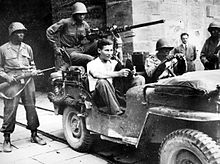
On 1 April, the 370th RCT and the attached 442nd Regimental Combat Team (Nisei) attacked the Ligurian coastal sector and drove rapidly north against light opposition from the German 148th Infantry Division, which was supported only by Italian coastal units. The 370th took over the Serchio sector and pursued the retreating enemy from 18 April until the collapse of all enemy forces on 29 April 1945. Elements of the 92nd Division entered La Spezia and Genoa on 27th and took over selected towns along the Ligurian coast until the enemy surrendered on 2 May 1945.
Casualties
- Total battle casualties: 2,997[17]
- Killed in action: 548[17]
- Wounded in action: 2,187[17]
- Missing in action: 206[17]
- Prisoner of war: 56[17]
Medal of Honor recipients
- John R. Fox, 1st Lt., Cannon Company, 366th Infantry Regiment, 92nd Infantry Division, near Sommocolonia, Serchio Valley, Italy, 26 December 1944.
- Vernon J. Baker, 1st Lt., Company C, 370th Infantry Regiment, 92nd Infantry Division, near Viareggio, Italy, 5–6 April 1945.
Note: The Medal of Honor was not awarded to these recipients until 1997.
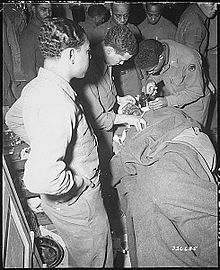
Order of battle
92nd Infantry Division (1942–45)
- Headquarters, 92nd Infantry Division
- 365th Infantry Regiment
- 370th Infantry Regiment
- 371st Infantry Regiment
- Headquarters and Headquarters Battery, 92nd Infantry Division Artillery
- 597th Field Artillery Battalion (105 mm)
- 598th Field Artillery Battalion (105 mm)
- 599th Field Artillery Battalion (105 mm)
- 600th Field Artillery Battalion (155 mm)
- 317th Engineer Combat Battalion
- 317th Medical Battalion
- 92nd Cavalry Reconnaissance Troop (Mechanized)
- Headquarters, Special Troops, 92nd Infantry Division
- Headquarters Company, 92nd Infantry Division
- 792nd Ordnance (Light Maintenance) Company
- 92nd Quartermaster Company
- 92nd Signal Company
- Military Police Platoon
- Band
- 92nd Counterintelligence Corps Detachment
Attached units:
- 366th Infantry Regiment (Nov, 1944 – Feb, 1945)
- 442nd Infantry Regiment (Nisei) (April 1945 – )
- 473rd Regimental Combat Team (formed from anti-aircraft units) (February 1945 – May 1945?).
- 758th Tank Battalion (Colored)
- 679th Tank Destroyer Battalion (Colored)
- 894th Tank Destroyer Battalion
- 701st Tank Destroyer Battalion
Task Force 1 (February 1945):]
- 3rd Battalion / 366th Infantry Regiment
- Company B, 317th Engineer Battalion
- 760th Tank Battalion
- 84th Chemical Mortar Battalion
- 27th Armored Field Artillery Battalion
See also
- Colonel Allen J. Greer, chief of staff, World War I
- Battle of Garfagnana, World War II
- James Harden Daugherty, soldier and author
- U.S. IV Army Corps, World Wars I and II
- Miracle at St. Anna, motion picture based on soldiers of this division
Notes
- ^ Video: U.S. Air ForAllied Bombers Strike On Two Fronts Etc (1945). Universal Newsreel. 1945. Retrieved 21 February 2012.
- ^ http://www.history.army.mil/html/books/023/23-2/CMH_Pub_23-2.pdf Order of Battle in the Great War P428
- ^ Wilson, p. 545.
- ^ McGrath, p. 173 – 174.
- ^ Scott, Emmett J. (1919). Scott's Official History of the American Negro in the World War. Chicago: Homewood Press. p. n.p.
- ^ "To Camp Funston," The Junction City (Kansas) Union, October 10, 1917, page 1
- ^ [1] "A Negro Zone at Funston," Junction City (Kansas) Weekly Union, 15 November 1917, page 2]
- ^ Infantry organization and History
- ^ Ready, J.Lee, Forgotten Allies: The Military Contribution of the Colonies, Exiled Governments and Lesser Powers to the Allied Victory in World War II
- ^ Motley, 1975. Pages 259-61, 274 and 288.
- ^ Ready, J.Lee, Forgotten Allies: The European Theatre, Volume I
- ^ Hodges, Robert Jr. (12 June 2006). "African American 92nd Infantry Division Fought in Italy During World War II". World War II magazine (World History Group, pub.) via Historynet.com. Archived from the original on 13 January 2015. Retrieved 23 March 2015.
- ^ Otfinoski, Steven (2011). African Americans in the Visual Arts. Facts on File Library of American History. p. 184. ISBN 978-0816078400.
- ^ Ricks, Thomaz E. "The Generals: American Military Command from World War II to Today" Penguin Press, 2012 ISBN 9781594204043 pages 152-53
- ^ Lee, Ulysses G. (1966). United States Army in World War II, Special Studies: The Employment of Negro Troops. Washington, D.C.: Center of Military History, United States Army. p. 572-575.
- ^ Kesting, Robert W. (1987). "Conspiracy to Discredit the Black Buffaloes: The 92nd Infantry in World War II". The Journal of Negro History. 72 (1/2): 1–19. doi:10.1086/JNHv72n1-2p1. JSTOR 3031477.
- ^ a b c d e Army Battle Casualties and Nonbattle Deaths, Final Report (Statistical and Accounting Branch, Office of the Adjutant General, 1 June 1953)
References
- Combat Chronicles of U.S. Army Divisions in World War II. U.S. Government Printing Office. Retrieved 9 July 2010.
- Gibran, Daniel K. (2001). The 92nd Infantry Division and the Italian Campaign in World War II. McFarland & Company. ISBN 0-7864-1009-4.
- Gibson, Jr., Truman K. (2005). Knocking Down Barriers: My Fight for Black America. Northwestern University Press. ISBN 0-8101-2292-8. Retrieved 26 November 2006.
- Hargrove, Hondon B. (1985). Buffalo Soldiers in Italy: Black Americans in World War II. McFarland & Company. ISBN 0-89950-116-8.
- McGrath, John J. (2004). The Brigade: A History: Its Organization and Employment in the US Army. Combat Studies Institute Press. ISBN 978-1-4404-4915-4.
- Motley, Mary Penick. (1975) The Invisible Soldier: The Experience of the Black Soldier, World War II. Wayne State University Press ISBN 0814319610
- Ready, J. Lee (1985). Forgotten Allies: The Military Contribution of the Colonies, Exiled Governments and Lesser Powers to the Allied Victory in World War II. Volume I: The European Theatre. McFarland & Company. ISBN 978-0-89950-117-8.
- Rinaldi, Richard A. (2004). The U. S. Army in World War I: Orders of Battle. General Data LLC. p. 54. ISBN 0-9720296-4-8.
- Stanton, Shelby L. (1991). World War II Order of Battle. Galahad Books. pp. 166–167. ISBN 0-88365-775-9.
- Wilson, John B. (1999). Armies, Corps, Divisions, and Separate Brigades. United States Army Center of Military History. ASIN B000OJKX1S.
External links
- Division History 92d Infantry
- Vernon Baker (MOH recipient)
- John R. Fox (MOH recipient)
- The Buffalo Soldiers of World War II, a memoir based on journal kept by Ivan J. Houston, a Buffalo Soldier
- A Path to Lunch Liberation Day and the Liberation of America, The 92nd in Lunigiana and Versilia.
- Wilson, Dale E. (1992). "Recipe for Failure: Major General Edward M. Almond and Preparation of the U.S. 92d Infantry Division for Combat in World War II". The Journal of Military History. 56 (3): 473–488. doi:10.2307/1985973. JSTOR 1985973.
- Buffalo Soldier units and formations
- African-American history of the United States military
- Infantry divisions of the United States Army
- Military units and formations established in 1917
- Military units and formations disestablished in 1945
- United States Army divisions of World War I
- United States Army divisions during World War II
- African Americans in World War I

